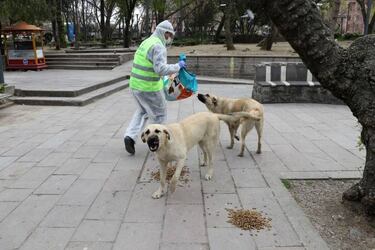Coronavirus: Did stray dogs cause the spread of the virus?
A new study published in Molecular Biology Evolution suggests a dog might have eaten bat meat contaminated with Covid-19 and passed it on to humans.

From bats to pangolin to stray dogs. A study at the University of Ottowa, published in Molecular Biology Evolution suggests the coronavirus could have been spread by bat meat eaten by stray dogs and then passed on to humans -- specifically dog intestine.
Xuhua Xia, a professor at the university, says that the focus on pangolin due to their presence in the markets that sell wild animals in like those in Wuhan, is wrong because they are "too divergent from the SARS-CoV-2" and so are looking for a different carrier of the disease, or an intermediary as it is called.
"Our observations have allowed the formation of a new hypothesis for the origin and initial transmission of SARS-CoV-2," said Xia. "The ancestor of SARS-CoV-2 and its nearest relative, a bat coronavirus, infected the intestine of canids, most likely resulting in a rapid evolution of the virus in canids and its jump into humans. This suggests the importance of monitoring SARS-like coronaviruses in feral dogs in the fight against SARS-CoV-2."

Covid-19 evolution able to bypass virus-fighting protein
Humans have a protein called ZAP, which tracks a virus when it enters the body and stops it from multiplying. This protein tracks a person’s lungs and is created in bone marrow and lymph nodes. SARS-CoV can bypass the ZAP protein, however, as has also been shown in HIV and other viruses that can not be fought off by the body.
"The most striking pattern is an isolated but dramatic downward shift in viral genomic CpG in the lineage leading to BatCoV RaTG13 which was reported to be sampled from a bat (Rhinolophus affinis) in Yunnan Province in 2013 but only sequenced by Wuhan Institute of Virology after the outbreak of SARS-CoV-2 infection in late 2019," said Xia. "This bat CoV genome is the closest phylogenetic relative of SARS-CoV-2, sharing 96% sequence similarity.
Related stories
"In this context, it is significant that the bat coronavirus (BatCoV RaTG13), as documented in its genomic sequence in GenBank (MN996532), was isolated from a fecal swab. These observations are consistent with the hypothesis that SARS-CoV-2 has evolved in mammalian intestine or tissues associated with intestine."
Live coverage of the coronavirus pandemic
You can keep up-to-date with the latest news on the Covid-19 crisis by following our daily live blog.